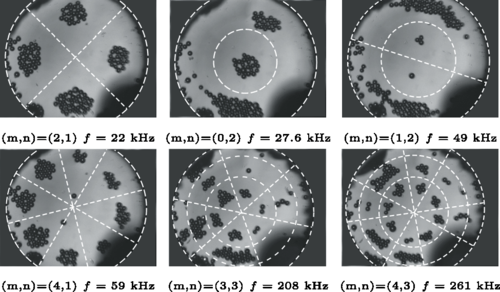May 6, 2016 report
Researchers investigate Chladni patterns in a liquid at microscale

(Phys.org)—A team of researchers with Université Grenoble Alpes in France has discovered that there are differences in patterns created in tiny particles immersed in water over a vibrating drum head, than in dry sand particles dropped on a metal plate and vibrated. In their paper published in Physical Review Letters, the researchers describe their experiments and the differences they found between the submerged particles, the patterns that developed and the mechanisms behind them.
Several centuries ago, it was noted that covering a plate with flour and causing the plate to vibrate resulted in the flour forming into different patterns, depending on the frequency of the vibration. Later it was noted that sand poured over the back of violin demonstrated the same types of properties—such patterns have subsequently been called Chladni Patterns and they have been used in designing musical instruments and other applications over the years. In this new effort, the researchers wondered if the same types of patterns would emerge in particles that exist in a water solution.
To find out, the researchers placed an amount of multi-sized microbeads into a container that had a membrane stretched across a base at the bottom, similar to a drum. They next filled the container with water and then watched (and filmed) what happened when the membrane was caused to vibrate at different frequencies.
The researchers found that the beads did migrate to form patterns, very similar to those in a dry environment, and they could be changed by adjusting the vibration frequency—but they also found that there were some differences. First, the patterns were not created the same way, instead of the finer grains getting pushed to nodes, they actually moved in the opposite direction, piling up at antinodes, forming what might be described as inverse Chladni patterns—due to a phenomenon known as acoustic streaming. But perhaps, more amusing, the team also found that under the right circumstances, i.e. causing vibrations that were off the resonant frequency, the microbeads could be caused to move in clusters around an outer circle, much like, they note, dancers engaged in a farandole.
The researchers note that their findings could have practical applications, like using vibrations to move particles in a fluid across a surface to a desired location in industrial applications, or more exotically, to move cells on a surface into a desired pattern before allowing them to grow.
More information: Gaël Vuillermet et al. Chladni Patterns in a Liquid at Microscale, Physical Review Letters (2016). DOI: 10.1103/PhysRevLett.116.184501
ABSTRACT
By means of ultrathin silicon membranes excited in the low ultrasound range, we show for the first time that it is possible to form two-dimensional Chladni patterns of microbeads in liquid. Unlike the well-known effect in a gaseous environment at the macroscale, where gravity effects are generally dominant, leading particles towards the nodal regions of displacement, we show that the combined effects of an ultrathin plate excited at low frequency (yielding to subsonic waves) together with reduced gravity (arising from buoyancy) will enhance the importance of microstreaming in the Chladni problem. Here, we report that for micrometric beads larger than the inner streaming layer, the microscale streaming in the vicinity of the plate tends to gather particles in antinodal regions of vibrations yielding to patterns in good agreement with the predicted modes for a liquid-loaded plate. Interestingly, a symmetry breaking phenomenon together with the streaming can trigger movements of beads departing from one cluster to another. We show that, for higher modes, this movement can appear as a collective rotation of the beads in the manner of a "farandole."
Journal information: Physical Review Letters
© 2016 Phys.org




















